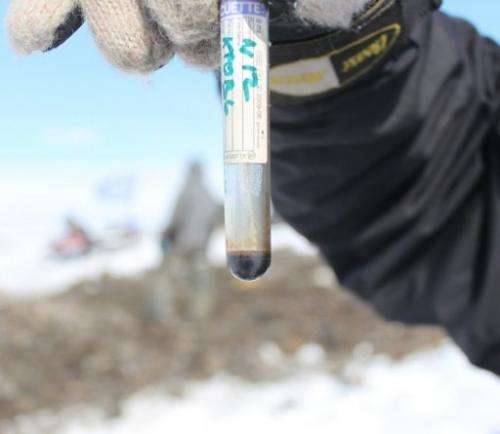Russian scientists make rare find of 'blood' in mammoth

Russian scientists claimed Wednesday they have discovered blood in the carcass of a woolly mammoth, adding that the rare find could boost their chances of cloning the prehistoric animal.
An expedition led by Russian scientists earlier this month uncovered the well-preserved carcass of a female mammoth on a remote island in the Arctic Ocean.
Semyon Grigoryev, the head of the expedition, said the animal died at the age of around 60 some 10,000 to 15,000 years ago, and that it was the first time that an old female had been found.
But what was more surprising was that the carcass was so well preserved that it still had blood and muscle tissue.
"When we broke the ice beneath her stomach, the blood flowed out from there, it was very dark," Grigoryev, who is a scientist at the Yakutsk-based Northeastern Federal University, told AFP.
"This is the most astonishing case in my entire life. How was it possible for it to remain in liquid form? And the muscle tissue is also red, the colour of fresh meat," he added.
Grigoryev said that the lower part of the carcass was very well preserved as it ended up in a pool of water that later froze over. The upper part of the body including the back and the head are believed to have been eaten by predators, he added.
"The forelegs and the stomach are well preserved, while the hind part has become a skeleton."
Follow Phys.org on Facebook: https://www.facebook.com/physorg
The discovery, Grigoryev said, gives new hope to researchers in their quest to bring the woolly mammoth back to life.
"This find gives us a really good chance of finding live cells which can help us implement this project to clone a mammoth," he said.
"Previous mammoths have not had such well-preserved tissue."
Last year, Grigoryev's Northeastern Federal University signed a deal with cloning pioneer Hwang Woo-Suk of South Korea's Sooam Biotech Research Foundation, who in 2005 created the world's first cloned dog.

In the coming months, mammoth specialists from South Korea, Russia and the United States are expected to study the remains which the Russian scientists are now keeping at an undisclosed northern location.
"I won't say where it is being kept or it may get stolen," he said.
Last year, a teenager from a nomadic family in Russia's north stumbled upon a massive well-preserved woolly mammoth, in what scientists described as the best such discovery since 1901.
The young male mammoth was dubbed Zhenya after the nickname of the boy who discovered it.
Global warming has thawed ground in northern Russia that is usually almost permanently frozen, leading to the discoveries of a number of mammoth remains.
© 2013 AFP










.jpg)









